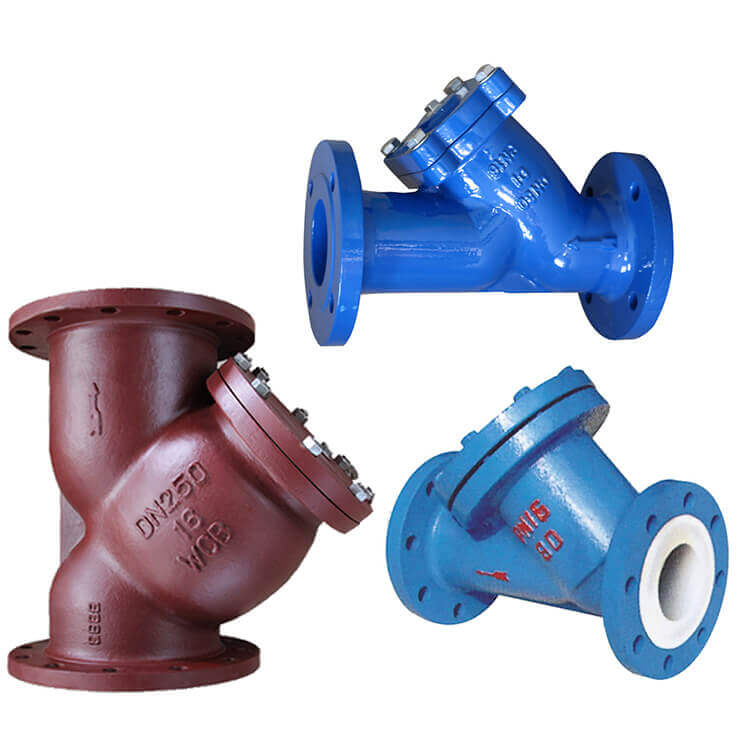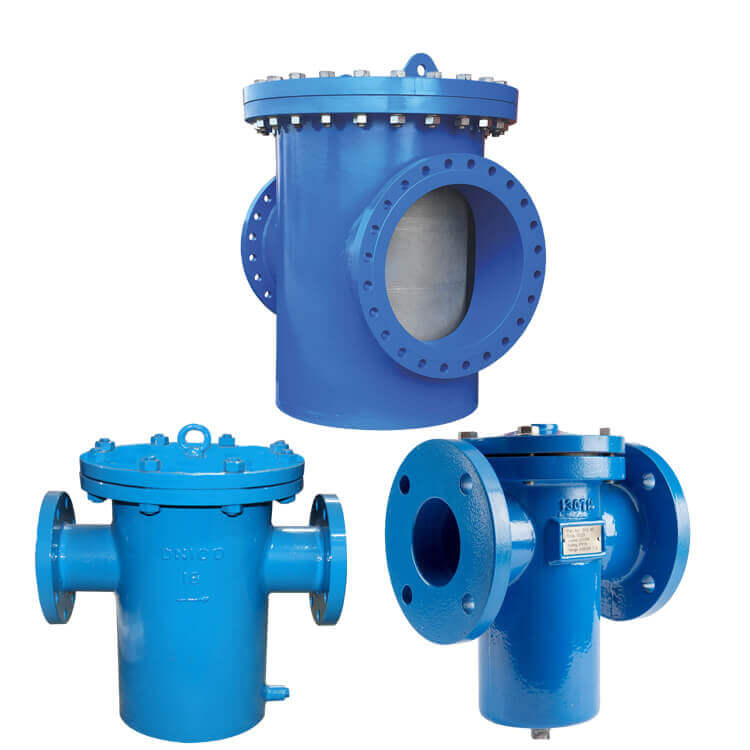Filters are widely used in petroleum and chemical industries. Solid impurities contained in gas and liquid phase materials are separated through filter elements to prevent equipment and pipe fittings from being damaged or blocked after entering the unit, to ensure regular and stable operation of production units. Therefore, how to design and use the filter correctly, safely, economically and reasonably is particularly important.Now, Let’s introduce how to choose pipe filters and filtration systems. And their respective characteristics.
According to its structure, the filter is mainly divided into two types: pipeline type filter and equipment type filter. This paper will compare and differentiate the two types of filters in terms of structure, performance, and application scope.
Pipe Type Filter
Pipe type filter is a typical coarse filter in the petrochemical industry. It is a pipeline element that ensures the reqular operation of process equipment by filtering solid impurities. According to its structure, it is generally divided into Y-type, T-type, etc
Y-Type Filter
The Y-type filter is usually installed at the inlet end of pressure reducing valve, constant water level valve or other equipment to remove impurities in the medium Y-type screen has the characteristics of advanced structure, low resistance and natural drainage.

T-Type Filter
The T-type filter is widely used in the pipeline of steam, air, water, oil and other media to protect all kinds of equipment on the pipeline system, such as pumps, valves, etc. from rust, welding slag and other sundries in the pipeline to block and damage the pipe. The T-type filter has the characteristics of strong anti-pollution performance, convenient drainage, large circulation area, small pressure loss, simple structure, low volume, etc.
The filter element inside the T-type filter is made of SS316L stainless steel,strong corrosion-resistance, long service life; the T-type filter is also divided into direct current type and baffle type, and the density of the filter screen is ten mesh – 120 mesh, temperature 0 ~ 450 ℃, can be selected according to user needs.

Selection Principle and Application Scope
The design and selection of pipeline filter are generally based on the nominal diameter of the inlet pipe, following SH / T 3411-1999 selection, inspection, and acceptance of screen for petrochemical pump and HG / T 21637-1991 chemical pipeline filter:
- First, the filter type is selected according to the nature of the medium, temperature, and pressure
- The pressure level of the screen is generally one level higher than that of the medium in the pipeline
- It is better to select the horizontal backwash filter for the medium with a high freezing point, high viscosity, and more suspended solids, which need to be purged frequently when the pipeline is shut down.
- A basket filter is generally used for a medium with more solid impurities and higher viscosity.
- For flammable, explosive, and toxic media, the filter connected by butt welding should be used. When the pipe diameter is less than DN40, the screen connected by socket welding should be applied.
- When the pipe is straight, When the diameter is less than DN400, Y-type / T-type filters should be selected. T-type filters should be chosen when the pipe diameter is greater than or equal to dn400.
- When the pipe diameter is less than or equal to DN80, a Y-type filter should be selected; when the pipe diameter is more excellent than DN80, a T-type filter and temporary filter should be selected; when the pipe diameter is less than or equal to DN100, the cone-shaped screen should be chosen.
Choice of Washable Filter Basket Specifications
The nominal diameter of the pipeline filter is generally DN15 ~ DN600. The filter basket made of single-layer stainless steel wire mesh is used as the filter element. The filter basket is made of 30 mesh/inch single-layer stainless steel wire mesh with filter accuracy as the standard mesh.
The mesh selection of the filter basket needs to meet the needs of the process or the protection function of the pump, compressor, and other fluid-conveying machinery. Objective: the active filtering area of the filter basket is generally more than twice the cross-sectional area of the connected Pipe type filter. The wire diameter and aperture specification of stainless steel wire mesh shall be selected according to GB / T 53302003.
After understanding the basic types of pipe filters and selection principles, it is helpful to walk through a practical step-by-step guide for choosing the right filter. This guide integrates technical standards and real-world considerations to help you make informed decisions efficiently.
Practical Guide for Pipe Filter Selection
- Identify the Fluid Type: Determine if the fluid is liquid, gas, or multiphase. Understand the chemical and physical properties of the fluid to ensure material compatibility and avoid corrosion or contamination.
- Determine Filtration Accuracy and Particle Size: Define the smallest particle size to be filtered, usually expressed in microns. Balance filtration precision with allowable pressure drop to maintain optimal system performance.
- Calculate Flow Rate and Pressure Requirements: Evaluate the maximum flow rate the system will handle to size the filter appropriately. Consider the operating pressure and the maximum allowable differential pressure of the filter for safe operation.
- Choose the Filter Type: Select from common filter types such as basket strainers, Y-type strainers, or filtration systems based on particle size and flow rate. Factor in installation space and maintenance accessibility.
- Material and Temperature Compatibility: Choose filter media and housing materials that withstand the chemical nature of the fluid and operating temperatures.
- Maintenance and Cost Considerations: Assess the ease of filter cleaning or replacement and factor in the costs of maintenance and downtime. Prefer reusable or washable filter elements when possible for long-term cost-effectiveness.
- Consult Professionals for Complex Applications: Seek expert advice when dealing with challenging fluids or complex systems to ensure the best filtration solution.
Filtering System
As a high-precision filter, the Filtering system is equipped with single or multiple filter elements. The equipment body is designed, manufactured, inspected and accepted according to the relevant standards of petrochemical pressure vessels.
Process Planning
Filter process design, as a critical step of equipment filter design, is generally based on medium process conditions, such as temperature, pressure, viscosity, density, flow, reliable impurity content, stable impurity process index at medium outlet, allowable pressure drop value, backwash requirements, instrument condition and other characteristic index requirements, etc., through determining filter element material and quantity, filter accuracy, equipment material and external structure size, and then design and manufacture the equipment shell according to the relevant standards of pressure vessel.
Technical Discussion and Clarifications
When choosing the right filter for your process pipe, several technical questions frequently arise regarding filter types, mesh sizes, and overall system performance. Understanding these details ensures optimal filtration and long-term reliability.
- What is the difference between a strainer and a filter?
Strainers are typically used to remove larger solid impurities and protect equipment like pumps and valves, while filters provide finer filtration to capture smaller particles and contaminants. Selecting the appropriate strainer or filter depends on the size of particles and specific process pipe requirements. - How does pressure drop impact filter efficiency?
A higher pressure drop across the filter element indicates increased resistance to fluid flow. Although a finer mesh screen improves filtering accuracy, it may cause significant pressure loss, reducing system efficiency. Balancing filtration efficiency and pressure drop is crucial for a reliable filtering system. - When should backwash or cleaning be performed?
For filters with reusable filter baskets or screen filters, backwash helps remove accumulated debris and prolongs filter longevity. Systems handling fluids with high silt or solid content benefit from regular backwash support to maintain continuous flow. - How to ensure material compatibility in filters?
Choosing filter media and housing materials compatible with the chemical composition and temperature of the fluid is vital. For example, SS316L stainless steel is commonly used for corrosion resistance in harsh environments. Proper material selection prevents contamination and filter degradation. - What maintenance practices improve filter performance?
Regular inspection of the differential pressure across the pipe filter indicates when cleaning or replacing the filter element is necessary. Scheduled maintenance ensures the filter system remains effective and avoids unexpected downtime. - Can filters be customized for specific industrial applications?
Yes, filters can be tailored by selecting appropriate filter types, mesh sizes, and connection styles to meet unique process requirements. Consulting with filtration experts or engineers is recommended for complex applications to ensure the best pipe and filter solution.
By understanding these technical points, users can select the most suitable filters in pipes, optimize filtration performance, and ensure the smooth operation of their systems.
How to Determine the Proper Size for a Process Filter?
The proper filter size depends mainly on the system’s flow rate and allowable pressure drop. Calculate the required filtration area by ensuring the filter can handle the maximum fluid flow without causing excessive pressure drop. Oversized filters reduce maintenance frequency but increase cost.
What’s the Best Way to Calculate Filter Dimensions for Your Pipeline?
Filter dimensions should match the nominal pipe size and the flow characteristics of the system.
Explanation:
Use the formula:
A=Q/V
Where:
- A= filter cross-sectional area (m²)
- Q= volumetric flow rate (m³/s)
- V = allowable fluid velocity through the filter (m/s)
Adjust A to ensure the velocity doesn’t exceed limits that cause high pressure drops.
How to Understand Filter Order and Its Relevance in Industrial Filtration?
Filter order generally refers to the complexity of filter stages or filtering precision, not commonly calculated like electronic filters. In industrial filtration, focus on micron rating and filtration stages rather than filter order. Higher order means more filtration stages or finer filtration.
How to Calculate the Required Airflow Rate (CFM) for Your Filter?
CFM (cubic feet per minute) is calculated from volumetric flow rate.
Use:
CFM=Q×2118.88/60
Where:
- Q = flow rate in m³/h
This converts cubic meters per hour to cubic feet per minute, helping size air filters.
What Factors Should You Consider When Choosing a Water Filter?
Choose based on contaminant type, flow rate, and required filtration precision. Water filters vary by micron rating, filter media compatibility, and pressure requirements to remove particles like sediment, chlorine, or biological contaminants.
What MERV Rating is Ideal for Residential Air Filtration?
MERV 8 to MERV 13 ratings are generally optimal for home use. MERV 8 provides basic dust and pollen filtration; MERV 13 offers better filtration for smaller particles like bacteria and smoke, balancing efficiency and airflow resistance.
Epilogue
The pipeline filter is usually installed on the inlet of the pump, compressor or the front pipe of the flow instrument to protect the equipment or device, unless, in particular, circumstances, it can be placed on the outlet of the pump, for example, in the catalyst production process, it can be placed on the outlet pipe of the shoe. The equipment filter is usually installed at the battery limit of the production unit and the entrance of coalescer to protect the regular operation of the device and the service life and safety of the equipment.
The main differences between Filtering system and pipeline filter are different filter elements, filter precision, equipment size, equipment design and manufacturing requirements. Although the pipeline filter has the advantages of simple structure, low manufacturing cost and small equipment size, it has the problems of low filtering accuracy, small filtering area and low structural strength of filter basket.
However, the Filtering system, due to its large filtering area and settling time, high filtering accuracy and structural strength, long service life and online flushing and replacement of filter elements can effectively solve the related problems of the above pipeline type filter and is more suitable for the long-term and stable operation of the device.
But compared with the pipeline filter, the Filtering system has a higher manufacturing cost. In industrial application, it can be used safely, economically and reasonably according to the use situation, physical properties of the medium and the requirements of the production process